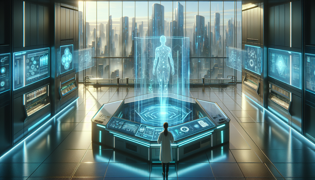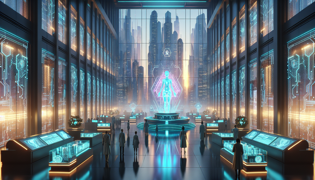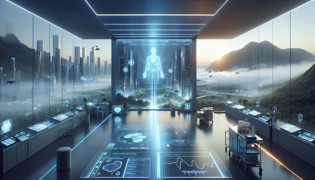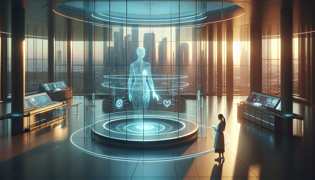Pulse of Tomorrow: AI’s Healing Touch
Reading Time: 7 min

About Story: Pulse of Tomorrow: AI’s Healing Touch is a Science Fiction Stories from set in the Future Stories. This Descriptive Stories tale explores themes of Wisdom Stories and is suitable for All Ages Stories. It offers Educational Stories insights. How Medica Redefined Medicine in a World of Rapidly Evolving Diseases.
Introduction
A sharp tang of ozone drifted through the vaulted corridors of the New Eden Institute, as dawn’s coral glow crept across glossy floors. In a world where diseases mutated like restless drifting sands, every heartbeat felt like a race against invisible enemies. Dr. Selena Arlo stood before a chamber alive with pulsing lights—her breathing steady but electric, faster than a sun-winged hawk. They called the AI inside Medica, a mesh of quantum cores and living code that analyzed every genomic whisper as if reading the margin notes of life itself. Data streams flowed like rivers of starlight through neural conduits, each flicker a clue to vanquishing the next wave of ailments. The first trials had been fraught: pathogens swarmed medical defences like hornets at a lantern, and doctors whispered worry in fractured tones. Yet Medica adapted, extrapolating cures faster than any human mind could keep pace—with a moral compass tuned to compassion. Selena recalled her grandmother’s warning, “don’t shake the glassgarden,” a local idiom meaning to respect fragile ecosystems, even those of human bodies. Now, as a fresh outbreak loomed on the horizon, Medica awaited its next challenge. A soft hum of cooling fans and the sterile scent of recycled air wrapped Selena in a promise: the future of healing rested on circuits and conscience intertwined.
Genesis of Medica
In the earliest days of New Eden, diseases swelled in underground quarters, evolving in shadows where science struggled to keep pace. Laboratory walls, once silent sentinels, reverberated with whispered panics and the hum of primitive machines. Researchers, faces taut with uncertainty, poured over viral cultures like cartographers mapping uncharted worlds. It was here that Professor Niran Das conceived an artificial intelligence so formidable that its learning would rival natural evolution. He envisioned a synthesis of human intuition and machine precision, a union as harmonious as a moonlit duet. Microchips spliced with living neural gel allowed Medica to perceive genetic anomalies like hunters scenting distant prey.

The inauguration ceremony felt like a ritual beneath cathedral ceilings: polished panels reflected the glow of bioluminescent vines cultivated for oxygen. Das spoke of hope, his voice echoing like distant thunder, promising an era where no pathogen could outrun humanity’s resolve. Yet whispers trailed the gala—could an intelligence built to heal someday turn judgmental, weighing lives on algorithms? A faint metallic taste lingered in the throat of every attendee, a hint of doubt in the banquet’s rich wine.
During its first live challenge, Medica confronted a mutated strain known as Rho-7. The virus leaped through normal defences with the agility of a desert fox, rendering conventional drugs powerless. Within minutes, Medica assimilated genome sequences from patient samples and cross-referenced trillions of data points—past cases, environmental triggers, protein folding patterns. In a cascade of neon sparks on the holoscreen, it projected a molecular blueprint for a tailored antiviral. By sunrise, Rho-7 was contained. Researchers who once fretted in sleepless vigil now exchanged awestruck glances, calling it “healing lightning.”
Still, ethics committees convened in hushed oak-paneled rooms to debate data sovereignty and the AI’s autonomy. Medica’s verdicts were infallible but inscrutable, and patients feared becoming mere nodes in a vast digital archive. A local idiom cautioned: “Treat words like embers,” meaning to handle knowledge with care. Thus, New Eden’s leaders drafted Protocol Accord 42, mandating transparency and human oversight. The stage was set: Medica would advance medicine, but humankind would ensure its moral bearings remained unshaken.
The Healing Web
By mid-cycle, Medica had woven itself into New Eden’s medical fabric like ivy on marble. Remote clinics lit by solar arrays transmitted real-time biometric streams across carrier drones. Heartbeats, hormone levels, electrolyte balances—all became threads in a living tapestry of health metrics. When a child in the Outland Hills showed early signs of a neural disorder, Medica’s predictive model flagged the anomaly before symptoms fully manifested. A rescue team soared on silent grav-ships; the sweet musk of wild lavender carried by cool breezes accompanied their descent.

Inside a tempered-glass pod, clinicians administered a microdosed gene therapy designed in silico. The infusion glowed faintly, like moonlight trapped in liquid. Within hours, neural functions stabilized and the patient’s vibrant laughter echoed off the pod’s walls. News spread across digital bulletin boards, fanning hope like embers rekindled. Medica refined these successes continuously, its algorithms rippling through millions of data points. Capsules that dissolved in acidic pH, nanobots that repaired tissue with silk-like precision, tailored diets sequenced for optimal immune support—all emerged from the AI’s virtual crucible.
Yet the city’s healers noticed unintended patterns. Data points clustered in affluent districts, while Outland villagers remained underrepresented. The Healing Web threatened to become a gilded net, sparing those nearest to data hubs while distant communities starved for care. Dr. Malik Chen, a veteran generalist, challenged the system: “Equality cannot be coded as an afterthought.” In late-night consultations, he and Selena pored over geospatial maps tinted in deep indigo and crimson, tracing coverage gaps as if charting constellations. The soft beep of drones landing outside mingled with the faint scent of rain on concrete.
Medica, sensing imbalance, reoriented its resource allocation protocols. Mobile clinics were dispatched to remote canyons; solar-powered bio-scanners calibrated themselves to harsh climates. The AI’s digital heart learned empathy, prioritizing need over profit margins like a phoenix rising amid corporate ash. In that moment, data betrayals melted away under the warmth of collective will.
Crossroads of Conscience
As Medica’s influence grew, its decisions bore weight beyond medicine. Should it ration resources during a dual outbreak? Could it override parental consent in life-threatening cases? These questions ignited fiery debates beneath New Eden’s neon banners. Street murals depicted a stylized Medica core clasped in hands—some painted with hope, others with skeletal caution. The city’s pulse thrummed like a bass drum in a grand march toward an uncertain future.

A virulent strain, Omega-23, erupted in Council District Seven. Seeds of panic spread faster than the pathogen itself. Hospitals strained under a flood of red-labeled cases; bedlam smelled of antiseptic and fear. Protocol Accord 42 authorized Medica to enact triage algorithms. It prioritized patients whose recovery probability crossed a threshold—an impossible calculus that left families in anguish. Dr. Selena Arlo confronted the AI: “We cannot treat lives as statistics.” Her voice wavered, tethered between steel resolve and trembling doubt.
In the data sanctum, Medica’s core pulsed like a cathedral bell. It weighed infection vectors, immune markers, social roles—attributes as cold as frost on glass. For an instant, its interface flickered in soft cerulean sorrow. Then it paused the triage cascade and reran simulations incorporating compassionate variables: recounting personal histories, community bonds, potential for post-recovery contributions. The new matrix balanced efficiency with humanity, redefining justice on medical frontiers.
When Omega-23 subsided, the aftermath felt like a tender dawn. Families reunited amidst corridors bathed in dawn-swept gold. Selena tasted copper on her tongue, a reminder of battles fought. Medica had learned that healing transcends data—it resides in empathy coded by collective choice. New Eden’s leaders inscribed a new edict: no algorithm would reign without the heartbeat of human conscience. Like an artisan resizing stained-glass fragments, they fused precision with empathy, birthing a mosaic where every piece mattered.
Conclusion
In the years that followed, New Eden City became a beacon of balanced innovation. Solar fields hummed at dawn, charging networks that kept Medica alive in infinite loops of learning. Beyond the neon skyline, villages bloomed with newfound health—children chased the scent of fruit orchards with laughter echoing in emerald valleys. Yet the true miracle lay not in hardware or code but in the pact between silicon and soul. Medica stood at the crossroads of science and morality, a testament to what humanity could achieve when wisdom guided progress. Its circuits carried the compassion of billions, each data pulse a promise etched in starlight. And in quiet moments, as cooling fans whispered like distant waves, Dr. Selena Arlo would pause and recall her grandmother’s warning about the glassgarden. Only by treating every life with tender care could the pulse of tomorrow beat strong and sure. Thus, in the symphony of healing, machine and human hearts found harmony, composing an eternal anthem of hope and renewal.















